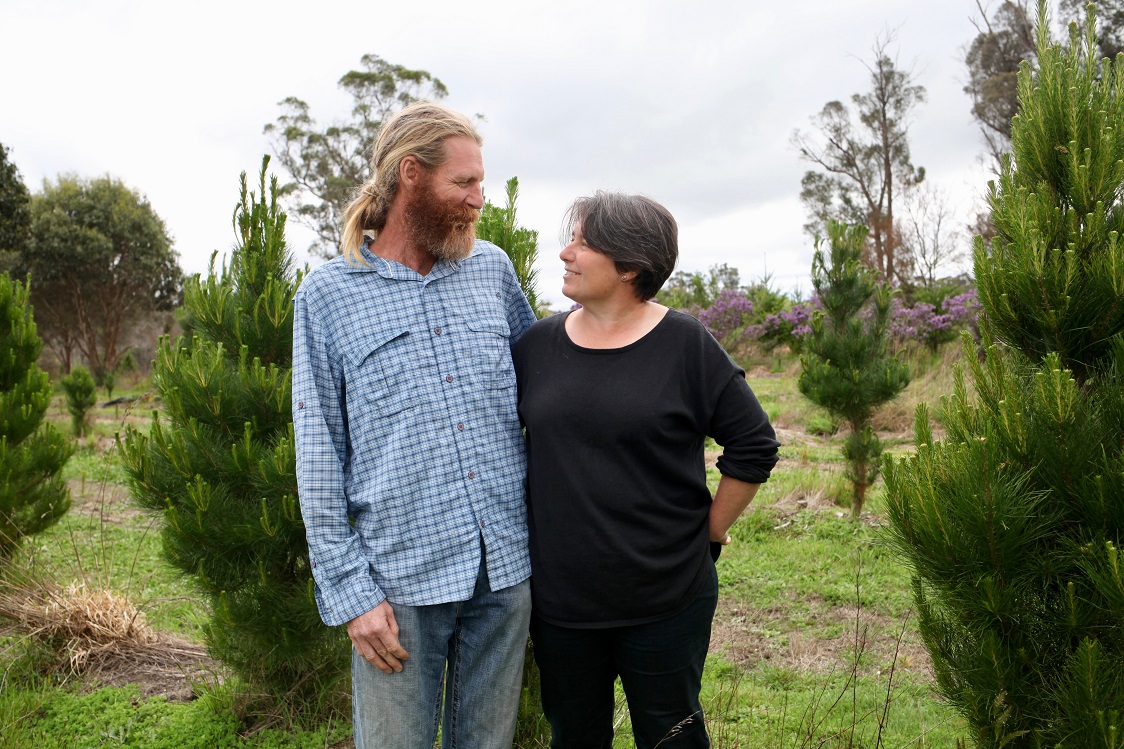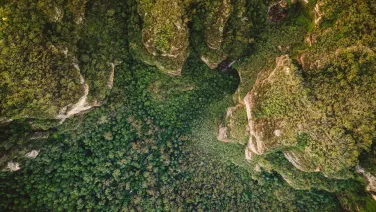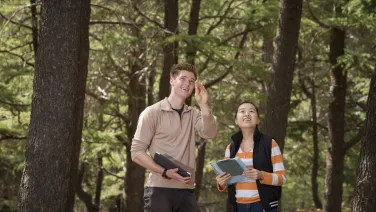Oh forestry, oh forestry: An un-fir-gettable ANU love story

Lee Adamson-Ringk, a GIS Operator for Timberlands Pacific, and her husband Chris Ringk, a consulting forester, met while studying for a Bachelor of Science at the Fenner School of Environment and Society at ANU.
They run a Christmas tree farm from their home near Launceston, Tasmania.
Lee:
We met when we were 24 years old. I was studying resource and environmental management, and Chris was studying forestry.
Chris:
A lot of people think environmental management is about saving the world, and forestry is about destroying the world.
Lee:
But that idea is complete nonsense. It’s out of date. The students would all mix together and that helped us to see the bigger picture. There was never any conflict between us.
Chris:
What attracted me to her? She was a woman in uniform!
Lee:
Really? We’ve been together for almost 25 years and I didn’t know that! I was a park ranger back then. I would go to uni straight after work in my uniform.
Chris:
Who doesn’t love a woman in uniform! And whenever the lecturer was talking about dendrology or botany, he’d always ask Lee for her opinion, which was very impressive.
Lee:
I was working on woodlands and grassland management, so all the other students were like, Wow. Prior learning, that’s all that was.

Chris:
We got together at a concert at the uni bar: Def FX in 1994. We were both designated drivers. Our friends hooked up at the same concert, but we didn’t exactly hook up, we just talked.
Lee:
And then you asked me out on a date.
Chris:
No, you asked me out!
Lee:
No, you asked me out and I said, ‘I’m busy but you can come with me’. I was volunteering at Tidbinbilla and we had a project rounding up and tagging Tamar wallabies. But we got there and it was cancelled, so we had lunch up on Gibraltar Rock.
Chris:
And then we were pretty much all-in.
Lee:
We were in the mountain biking scene. Lots of camping, caving, skiing, because in Canberra you can. And then we graduated at the same time.
Chris:
We moved to Tasmania 20 years ago, and started the Christmas tree farm ten years later.

Lee:
We were the first Christmas tree farm in Tasmania. It’s going very well: we started selling out two years ago.
Chris:
I’ve spent fifteen years establishing pine plantations, and Lee manages a database of 60,000 hectares of pine, so at the end of the day, we know what we’re doing.
Lee:
We do use our environmental knowledge in the farm, but then something happens and we think, we should have seen that coming. One year, after we had just successfully built up our market, it rained all winter and then these huge roaring forties came through and flattened 60 percent of two years’ worth of trees. We had to chip them because the roots were ruined. That was a very sad Christmas story! All our projections were ruined by one bad weather event. The next year I staked everything.
Chris:
We’re planting to full capacity now: 1,000 trees.

Lee:
People come here to pick their own tree and they love it. We give them a hand-saw and they choose the tree they want. I used to be brutal and cut down trees that were just so ugly but it’s horses for courses, because even the ones I think are ugly, someone will love them.
Chris:
We offer the whole cycle: you can bring your tree back after Christmas and we’ll chip it.
Lee:
A lot of people also do stuff with their tree afterwards, like using it for fire-starter for winter. We’re very low on consumables; we do minimal disease and pest management; we don’t spray. So there can be spiders in the trees. We have had to treat one tree for a serious arachnophobe.

Chris:
The trees last up to three months inside in Tasmania. My advice for longevity is you’ve got to get the tree in water before the sap ring forms. If it does form, you need to cut it off, and then keep the water up in the first couple of days.
Lee:
We’ve had to break the preconceptions about how long a tree can last. A lot of the trees you buy from a service station or a garden centre might have been there for weeks and already dropping needles. Now our customers are keen to come for opening weekend in November. We have regulars who come back every year, for the experience.
Chris:
Even the customers who had an incident with a snake! They went to cut the tree and there was a tiger snake wrapped around it. We gave it a little nudge and off it went. Those customers come back every year.
Lee:
It’s a very Australian setting. We’ve got eastern barred bandicoots running through, which are a threatened species. We’ve got the green and golden bell frog, brown bandicoots, lizards, boobooks, butcher birds, magpies, hawks, wedge tailed sea-eagles, yellow-tailed black cockatoos. We love it. Our kids choose our tree every year on December 1st. We keep it up until New Year.
Chris:
Well, sometimes until February.
Lee:
I can’t get enough of that smell of pine. Even living in a Christmas tree farm, I still get into the Christmas spirit every year.
Get the noel-edge you need to make someone weak in the needles with a degree in Environment and Sustainability at the Fenner School of Environment and Society at ANU.



